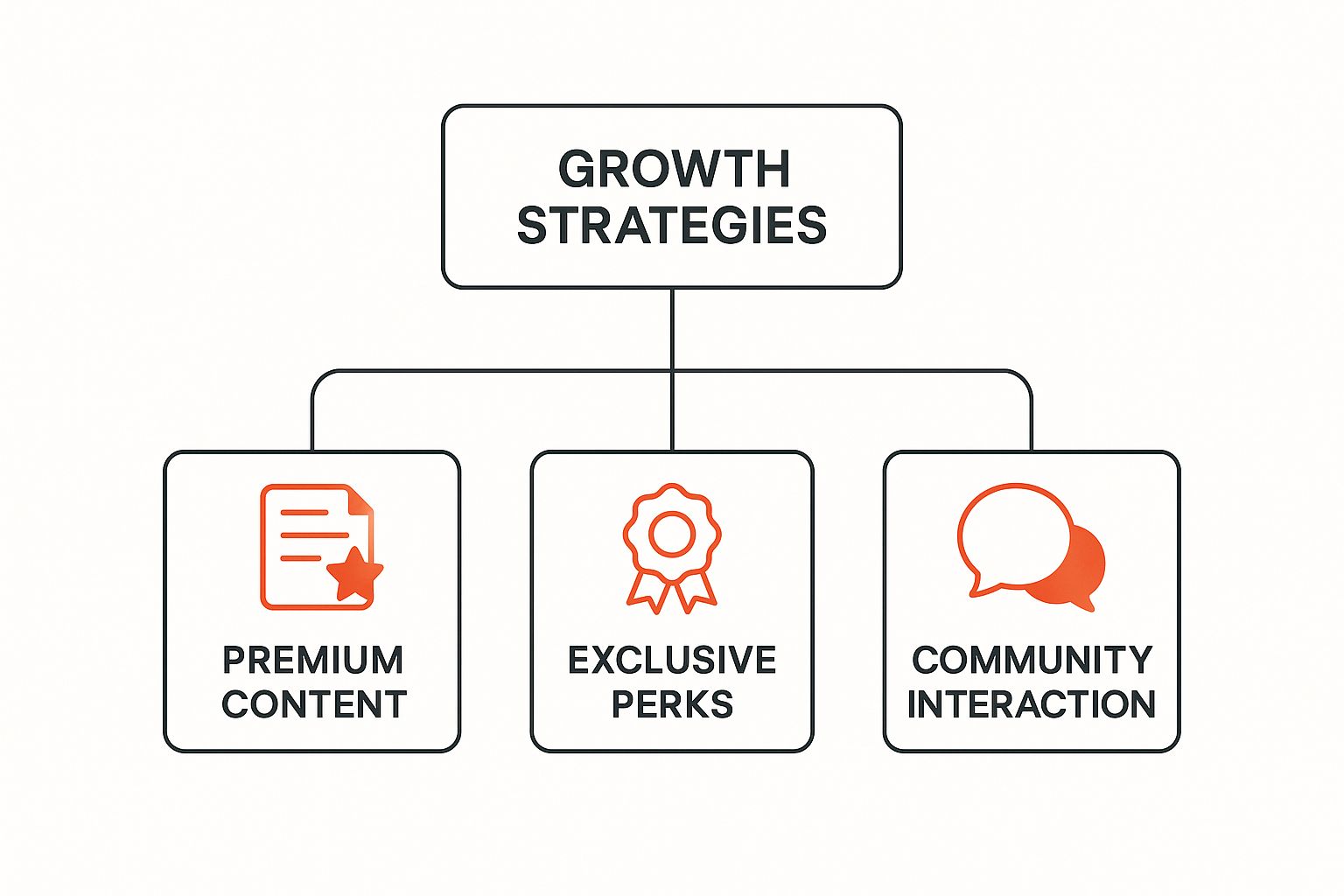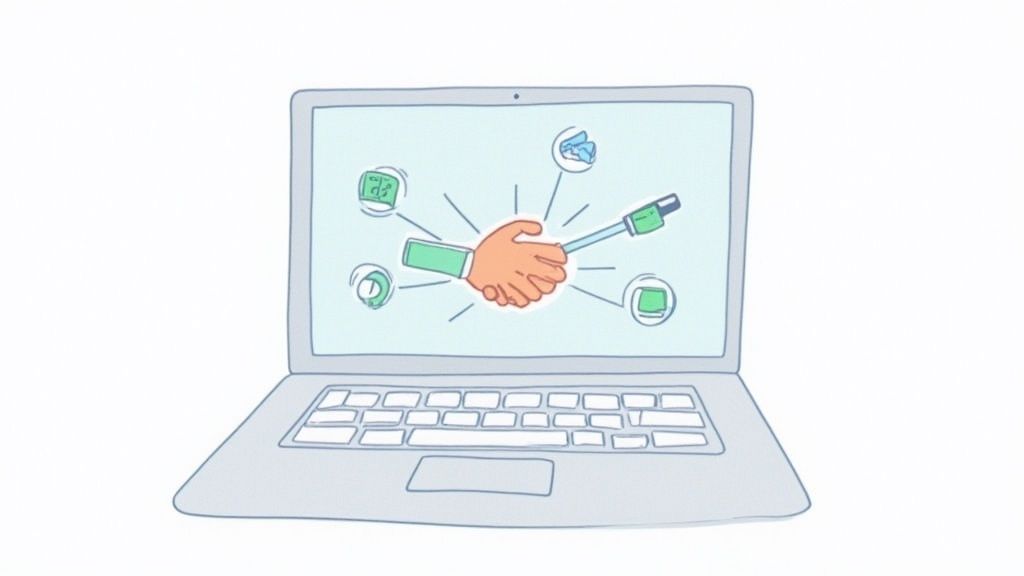Paid Memberships: Boost Revenue & Build Loyalty
Imagine turning your casual shoppers into dedicated fans who pay to be part of your brand. That's the magic of a paid membership. It’s a powerful strategy that moves your business beyond one-off sales, creating predictable income and fostering incredible customer loyalty.
You're not just selling products anymore; you're building a community.
The Power of Paid Memberships in Modern E-commerce
Let's be honest, the old way of doing e-commerce—focusing on one sale at a time—is a grind. It's a never-ending cycle of finding new customers. A paid membership program flips that script entirely. You're creating an ongoing relationship, inviting customers into an exclusive club where they get consistent value for a recurring fee.
This isn't just some passing trend. It's a fundamental part of the "subscription economy," which has completely changed how people shop. By 2025, this market is expected to rocket past $1.5 trillion. Think about that: subscription-based companies have seen a mind-blowing 435% growth over the last decade. This tells us one thing loud and clear: customers want convenience, personalization, and curated experiences they can count on.
Why Customers Pay for Access
So, what makes someone willing to pay for a membership? It’s a psychological shift. They're not just buying stuff; they're investing in a better experience. This usually boils down to three key things:
- Exclusivity: People love feeling special. Members get perks that regular shoppers don't, like early access to new products, members-only sales, or unique content. It makes them feel like a true insider.
- Convenience: Think free and fast shipping, hassle-free returns, or "subscribe and save" discounts that take the friction out of shopping. Amazon Prime didn't get 200+ million members by accident—they mastered convenience.
- Community: A great membership program builds a tribe. It connects people to your brand and to each other through private forums, special events, or shared values.
When you weave these three elements together, you stop just selling things and start building relationships. You create a protective moat around your business that makes it incredibly difficult for competitors to steal your customers.
Of course, a membership program only truly shines when it's part of a well-oiled machine. This means implementing e-commerce best practices across your entire site. A slick, high-performing storefront makes it easy for people to sign up and stay engaged, paving the way for sustainable growth.
Unlocking the Core Benefits of Membership Programs

Beyond the initial buzz, a well-executed paid membership is a serious engine for growth. Its most immediate impact? The creation of predictable, recurring revenue. This is a huge shift, transforming your cash flow from a rollercoaster of seasonal spikes and dips into a steady, reliable income stream.
Think of a traditional e-commerce store as a farmer who only gets paid at harvest time, hoping for good weather and a strong crop. A membership program is like that same farmer running a Community Supported Agriculture (CSA) program. Customers pay upfront for their weekly box of produce, giving the farmer guaranteed income to plan, invest in better equipment, and weather any storm.
That kind of financial stability is a game-changer for any merchant.
Building Deeper Customer Relationships
Another massive win is the boost in Customer Lifetime Value (LTV). Members are, by their very nature, more invested. They aren't just making a one-off purchase; they’re choosing to make your brand a part of their regular routine.
This built-in engagement naturally leads to them buying more often and spending more over time than non-members. They become your most valuable customers, not just because of their subscription fee, but because of their consistent loyalty. This is where you can start digging into more advanced customer retention strategies to keep your best people happy.
By shifting focus from one-time transactions to long-term value, you create a loyal following that simple discounts can't replicate. You're building an asset, not just making a sale.
While paid memberships are a powerful tool, they share a common goal with other engagement tactics. To see how these concepts overlap, check out our guide on how to create a loyalty program that boosts growth.
Leveraging Member Data for Smarter Decisions
Finally, a paid membership is a goldmine of first-party data. Every single interaction—what members buy, which articles they read, what perks they redeem—paints a crystal-clear picture of who they are and what they truly want.
This data is your secret weapon for creating hyper-relevant experiences. You can fine-tune marketing messages, recommend products with startling accuracy, and even shape your next product line based on the proven habits of your most dedicated fans. You get to stop guessing and start making data-driven decisions that fortify your entire business. It's a direct feedback loop that you just can't get from anonymous shoppers.
How to Design Your Membership Tiers
Figuring out the right structure for your paid memberships isn't about throwing ideas at a wall and seeing what sticks. It’s a strategic process. Think of it like a restaurant designing its menu—some might thrive with a single, perfectly curated prix fixe meal, while others need a multi-course tasting menu with different levels of indulgence. Your goal is to offer choices that feel both valuable and perfectly natural to your customers.
The most popular way to do this is with a tiered model. This approach lays out a clear path for people to join at a level they're comfortable with and, hopefully, upgrade later. This whole idea leans on a simple but powerful psychological trigger: value distinction. Each tier needs to offer a clearly better set of benefits than the one below it. This makes upgrading feel like a smart move, not just an extra cost.
Choosing Your Core Tier Model
When you're ready to build your program, you’ll find a few time-tested models to choose from. For some brands, a simple, all-in-one approach is the way to go. You offer one price, and everyone gets the same great benefits. It’s a beautifully straightforward way to join, perfect for businesses built around a single, knockout value proposition, like unlimited free shipping.
On the other hand, a multi-level structure gives you more flexibility and lowers the barrier to entry. You could start with a free or low-cost introductory tier offering basic perks, followed by a mid-level tier with more substantial benefits, and finally, a premium VIP tier that unlocks exclusive access and personalized services. This strategy casts a wider net, appealing to a broader range of customers and budgets.
The real secret is making the jump in value between tiers impossible to miss. If a customer has to squint to see the difference between your "Silver" and "Gold" plans, you've already lost them. Upgrading should feel like a no-brainer.
Starting from scratch can feel overwhelming, but it doesn't have to be. If you're looking for a complete A-to-Z playbook, our guide on how to create a membership website walks you through every step of the process.
Building Value Into Each Level
Once you’ve settled on a model, the real work begins: deciding what perks and benefits go into each tier. The best paid memberships are built on a compelling mix of premium content, can't-get-it-anywhere-else perks, and a real sense of community.

This pyramid shows you the core ingredients for growth that make a membership program truly sticky. The most successful brands sprinkle these elements across their tiers to create a balanced and irresistible offer. For instance, a basic tier might unlock exclusive content, while a premium tier adds special perks and a password to a private community forum.
To make this crystal clear, let's break down the most common structures you can use.
Comparison of Paid Membership Tier Models
This table breaks down the three most common membership tier structures, outlining their core concepts, ideal business applications, and key strategic considerations to help you choose the right model.
| Model Type | Core Concept | Best For | Key Consideration |
|---|---|---|---|
| The All-in-One | One price, one set of benefits. Simple and direct. | Brands with a strong, singular value proposition (e.g., free shipping). | Ensure the value offered is high enough to justify the single price point. |
| Tiered (Good-Better-Best) | Multiple levels with progressively increasing value and price. | Businesses wanting to attract a wide range of customers with different budgets. | The value difference between tiers must be clear and significant. |
| Metered/Usage-Based | Members pay based on their consumption (e.g., number of articles read). | Content-heavy sites like news publishers or digital libraries. | Requires tracking usage and can create unpredictable revenue. |
In the end, the best structure is the one that aligns perfectly with your business goals while tapping into what your specific customers truly value.
Inspiring Examples of Successful Memberships

It’s one thing to talk about membership models in theory, but seeing them work in the real world is where things get interesting. The most successful programs aren’t just glorified discount clubs; they’re a masterclass in blending convenience, exclusivity, and community into something customers genuinely want to be a part of.
Looking at how the top brands pull it off can spark some great ideas for your own store. A popular beauty brand might give members a head start on new product launches, while a fitness apparel company could offer exclusive workout content. The key is that each program is built around what its specific audience truly values, turning a simple purchase into a real relationship.
The lesson here? Your membership needs to solve a problem or fulfill a desire so well that paying a recurring fee feels like a no-brainer for your customers.
The Amazon Prime Playbook
You can't talk about paid memberships without mentioning the 800-pound gorilla in the room: Amazon Prime. It’s the benchmark for a reason. Prime is a masterclass in creating an offer so loaded with value that it becomes an indispensable part of daily life for millions. At its core, it solved the biggest headache in e-commerce—the cost and agonizing wait for shipping.
But the real genius of Prime is how it continuously layers more and more benefits on top of that initial promise. It’s so much more than just free two-day shipping. It has become a massive ecosystem of value, including:
- Streaming Content: A huge library of movies and TV shows through Prime Video.
- Exclusive Deals: Early access to Lightning Deals and, of course, the massive member-only event, Prime Day.
- Extra Perks: Things like Amazon Music, Prime Reading, and unlimited photo storage that sweeten the deal.
This multi-layered approach makes the membership incredibly "sticky." Someone might sign up for the free shipping, but they'll stay for the movies, making it much harder to ever hit that "cancel" button.
Amazon's strategy teaches a powerful lesson: bundle different types of benefits together. When you do, you create a value proposition that feels far greater than the sum of its parts, making the decision to join—and stay—an easy one.
The program's staggering growth tells the story. By 2025, Amazon Prime swelled to over 240 million subscribers worldwide, a massive 33.33% jump from its 150 million members back in 2019. Beyond the retail world, Prime Video has also become a powerhouse, capturing a 22% share of the U.S. streaming market and going toe-to-toe with established giants.
You can dig into more stats about Amazon Prime's dominant market position on yaguara.co. It’s a perfect example of how a well-designed membership can not only anchor your main business but also sprout entirely new, highly profitable ventures.
Taking Your Membership Program Global

So, your paid membership program is a hit on your home turf. What's next? For many ambitious brands, the answer is taking it worldwide. But launching internationally is a whole different ballgame. Simply translating your signup page and hoping for the best just won't cut it.
Real success abroad comes from digging deep into the local culture, understanding the economic realities, and getting a feel for what customers in that specific market actually want and need. A one-size-fits-all strategy is almost guaranteed to stumble. What resonates with your audience in North America could completely miss the mark in Southeast Asia, especially when it comes to how—and how much—they’re willing to pay.
Adapting Your Billing and Benefits
One of the first things you'll need to rethink is your billing. How people prefer to pay for subscriptions can change dramatically from one country to another. For instance, recent data shows that yearly plans are the go-to in Asia-Pacific (47%) and North America (43%), where people are often comfortable with a bigger upfront commitment for a better deal.
But if you look at India, Southeast Asia, or the Middle East and Africa, the story flips. In those regions, weekly plans are surprisingly popular, preferred by 36% and 35% of customers, respectively. This data, which you can explore further in the State of Subscription Apps report from RevenueCat, is a clear signal: you have to offer flexible billing cycles that match local habits.
Of course, it’s not just about the money. The perks you offer need a local touch, too.
- Shipping Benefits: If you're entering a market where two-day shipping is the norm, maybe offering free returns is the perk that will truly stand out. Conversely, in a region with shaky logistics, just guaranteeing the delivery date could be the most valuable benefit you offer.
- Content and Community: Your exclusive content has to connect culturally. A how-to video that's a hit in the U.S. might need to be completely reframed for an audience in Japan. Your community spaces also need to feel inclusive, which means supporting local languages so people can actually connect.
- Payment Methods: This one is non-negotiable. You absolutely must offer payment methods people in that region already know and trust. That could mean integrating popular digital wallets in Asia or even offering cash-on-delivery options where it’s common.
Expanding your program globally means thinking like a local. Instead of just pushing your existing model, you must pull insights from each new market and adapt your offering to meet their unique expectations and needs.
Building a Global Blueprint
Taking a membership program global isn't about copying and pasting your success. It’s about smart, strategic adaptation.
Don't try to conquer the world all at once. Start by picking one or two promising markets and do your homework. Get to know their e-commerce habits, what payment methods they use, and what your local competitors are doing.
Then, launch a small, tailored pilot program. Experiment with different billing options—monthly, quarterly, yearly—to see what sticks. Most importantly, talk to your first international members. Ask them what they love, what's missing, and what would make their experience even better. This hands-on approach of testing, learning, and iterating is how you build a flexible and powerful global membership strategy that can truly scale with your brand.
Common Questions About Paid Memberships
Taking the plunge into paid memberships is a big move, and it's totally normal to have a lot of questions buzzing around. You're probably wondering what perks to offer, how to nail the pricing, or what common mistakes to sidestep. Getting solid answers to these questions upfront is the key to building confidence and starting off on the right foot.
Let’s walk through some of the most common things merchants ask when they’re thinking about launching a membership. We'll break it all down so you can move forward with a clear, winning game plan.
What Are the Essential Benefits I Should Offer?
Think of a standout membership program like a fantastic meal—it needs a mix of tangible (transactional) and intangible (emotional) ingredients to really hit the spot. Transactional benefits are the practical, logical reasons someone signs up. They give a clear, immediate payback on the membership fee.
These are the heavy hitters you'll see most often:
- Free or expedited shipping: For many customers, this is the single most convincing reason to join.
- Exclusive discounts: A standing discount, like 10% off every purchase, makes the membership feel valuable from the very first order.
- Early access to sales: Letting members get first dibs on major sales events makes them feel like true insiders.
Emotional benefits, on the other hand, are what create a real connection and make your membership feel indispensable. These perks tap into that human desire to belong and feel special. This could be anything from access to a private community forum, members-only content like tutorials or behind-the-scenes videos, or simply the feeling of being part of an exclusive club.
The most successful programs find that perfect sweet spot between the practical and the personal. Start by figuring out your customers' biggest headaches (like shipping costs) and their strongest desires (like feeling part of a community) to craft an offer they can't refuse.
How Do I Price My Membership Program?
Pricing is always a bit of a balancing act. You need to weigh the value you're providing against your own costs and what your customers are willing to pay. It can feel like a shot in the dark, but a simple three-step approach can bring a lot of clarity.
First, do the math. Calculate the hard costs of your benefits. If you're offering free shipping, what's your average shipping cost per order? If you're giving a discount, what does that do to your profit margins? Understanding these numbers gives you a concrete cost-of-goods-sold for your program.
Next, do a little recon. See what competitors or similar brands are charging for their own paid memberships. This gives you a general idea of what the market is used to and helps you position your own offer.
Finally, and this is the most important part, focus on value-based pricing. The real question is: what is this whole package actually worth to my ideal customer? A great rule of thumb is to price your program so that a moderately active member "breaks even" after just two or three purchases. This makes the decision to join feel like a no-brainer with very little risk and a whole lot of upside. If you're using tiers, make sure each level offers a clear and significant jump in value to justify the higher price.
What Are the Biggest Challenges to Avoid?
The two biggest gremlins you'll likely face are member churn (people canceling) and benefit fatigue (when your perks get stale). To fight churn, you have to keep your members engaged, constantly. Remind them of the value they’re getting with exclusive content, surprise bonuses, and community events. A membership is not a "set it and forget it" product; you have to actively nurture it. For more on this, our guide on powerful customer retention strategies has a ton of great ideas.
To prevent benefit fatigue, you need to keep things fresh. This doesn't have to be a massive overhaul. It could be as simple as adding a new partner discount, dropping some fresh members-only content, or introducing a small new perk every few months.
The other major hurdle can be the technology itself. A clunky, unreliable system for managing payments and member access is a recipe for disaster. It frustrates your customers and creates an administrative nightmare for you. Using a dedicated, dependable platform is absolutely critical to making the entire experience smooth for everyone.
Ready to stop wondering and start building? With Toki, you can launch a stunning, professional paid membership program on Shopify in just minutes. Our platform gives you all the tools you need—from tiered memberships and recurring billing to exclusive content and community features—to turn casual shoppers into your most loyal fans.